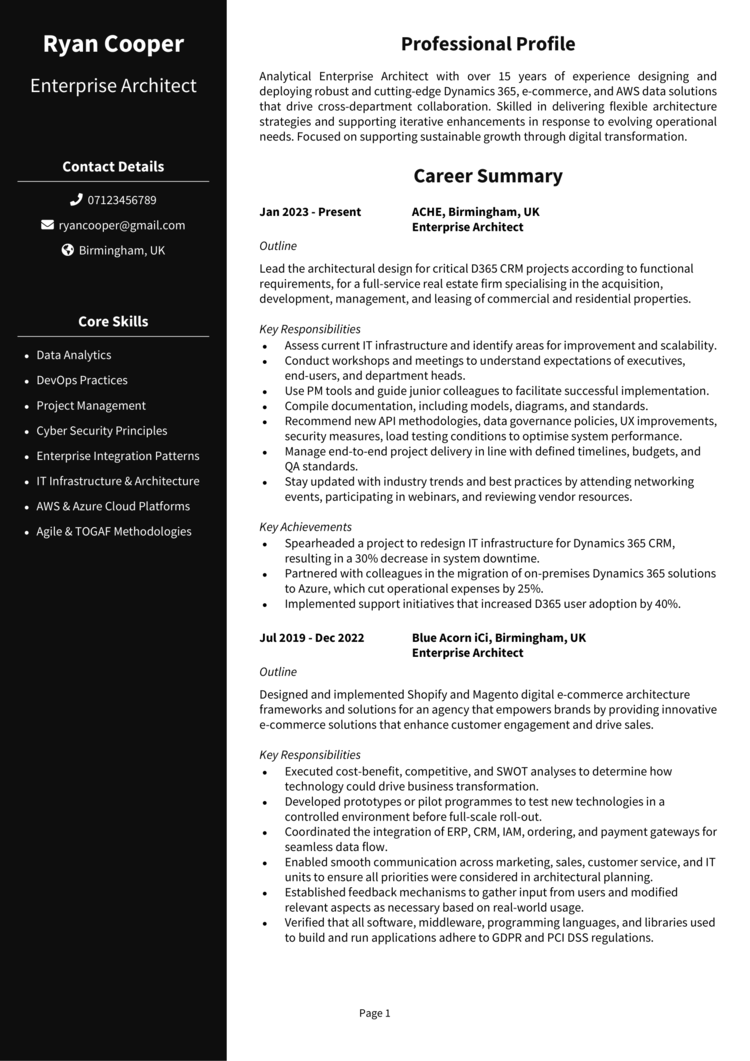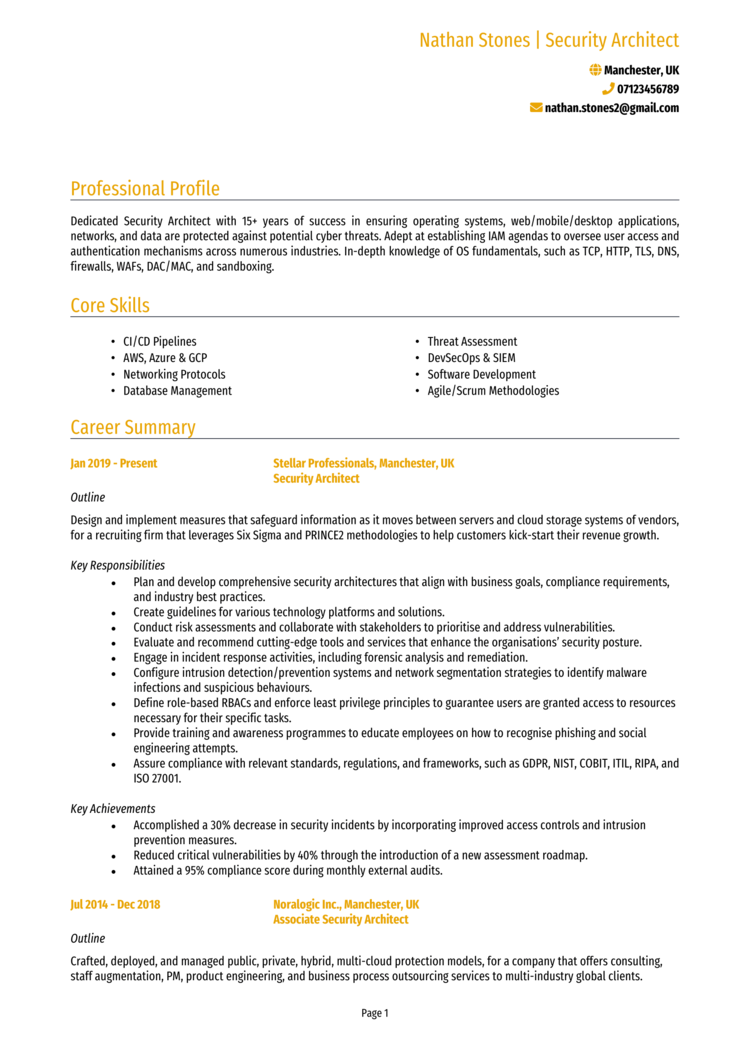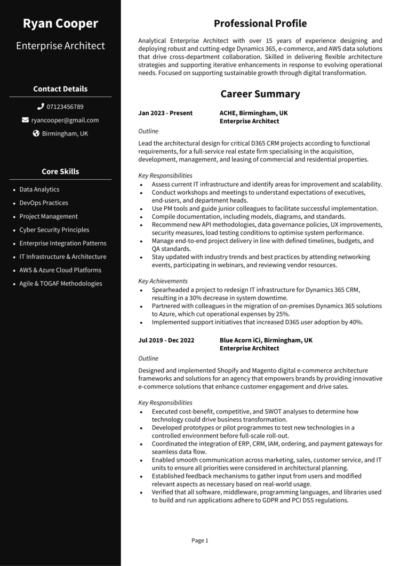Are you ready to design the blueprint for an organisation’s IT success? Because no one’s hiring a systems architect who can’t structure their own CV!
This guide, complete with these Enterprise Architect CV examples, will help you create a CV that highlights your technical expertise, strategic thinking, and leadership capabilities to secure your next big role.
Enterprise Architect CV example

Security Architect CV example

How to write your Enterprise Architect CV
Learn how to create your own interview-winning Enterprise Architect CV with this simple step-by-step guide.
Crafting an Enterprise Architect CV requires more than just listing your certifications and skills – it’s about demonstrating your ability to design systems and strategies that deliver measurable business value.
This guide will help you organise your experience, highlight your expertise, and present your vision for aligning IT with business needs.
How should you structure your Enterprise Architect CV?


Your CV should be written as sleek and organised as the IT systems you design – no glitches, no 404s, just smooth navigation. Recruiters don’t want to troubleshoot a messy CV. Keep it clear and logical, or risk getting lost in the system
Here’s how to structure your Enterprise Architect CV:
- Name and contact details – Place these personal details at the top for easy access. Including a photo is entirely optional.
- Profile – Open with a compelling overview of your skills, experience, and career goals, and strategic achievements.
- Core skills – List your key abilities in this section, focusing on those that will be most relevant to the job.
- Work experience – Walk through your professional experience, beginning with your latest position and moving backwards. Focus on your strategic contributions and measurable results.
- Education – Mention your degrees, certifications like TOGAF or AWS, and any training that supports your career path.
- Additional info – You could also add hobbies and interests that reflect your problem-solving mindset or passion for innovation.
Enterprise Architect CV format


Formatting your CV is like optimising an IT system – if it’s clunky or disorganised, users (or recruiters) will abandon it. Remember: even the best candidates can lose out if formatting mistakes make their CV hard to navigate.
Here’s how to format your Enterprise Architect CV:
- Bullet points – Break down technical responsibilities and results into clear, skimmable points.
- Divide sections – Use bold headings and consistent spacing to make your CV easy to navigate.
- Use a clean font – Opt for a professional layout with a readable font that conveys authority.
- Keep it the right length – Make sure it’s no more than 2 pages, which provides all the essential detail while keeping things concise.
Writing an Enterprise Architect CV profile


Your profile is like the opening pitch in a client presentation – it’s your chance to wow recruiters with your vision and capabilities. For an Enterprise Architect, this is your chance to showcase your ability to align IT strategies with business objectives.
Enterprise Architect CV profile examples
Profile 1
Strategic Enterprise Architect with over 10 years of experience in designing and implementing scalable IT solutions for multinational organisations. Skilled in aligning technology strategies with business objectives, managing cloud migrations, and improving system interoperability. Proficient in TOGAF, AWS, and Azure architecture frameworks.
Profile 2
Organised Enterprise Architect with seven years of experience in the financial services sector, focusing on modernising legacy systems and integrating emerging technologies. Adept at collaborating with stakeholders to deliver cost-effective, future-proof IT solutions. Experienced in using ArchiMate and VMware for enterprise design.
Profile 3
Proficient Enterprise Architect with 12 years of experience in public sector digital transformation, specialising in enterprise-wide IT frameworks, cybersecurity protocols, and cross-departmental system integrations. Skilled in leveraging frameworks like TOGAF and ITIL to drive efficiency and innovation.
What to include in your Enterprise Architect CV profile
Here are some tips on what to include in your Enterprise Architect CV profile:
- Where you’ve worked – Mention organisations where you’ve driven IT transformation or strategic planning.
- Your top qualifications – Highlight certifications like TOGAF, AWS Solutions Architect, or ITIL.
- Key skills – Include strengths like enterprise architecture frameworks, digital transformation, and cloud strategy.
- Business impact – Reference your ability to reduce costs, improve system efficiency, or drive innovation.
- Leadership expertise – Mention your experience managing teams, stakeholders, or cross-functional collaborations.
Core skills section


Think of your core skills section as your system’s dashboard – it gives recruiters a quick view of your most valuable features
For Enterprise Architects, this should include system design, business alignment, and leadership skills. Tailor these to the specific role, emphasising the technologies and strategies most relevant to the employer.
Key skills for your Enterprise Architect CV
- Enterprise Architecture Frameworks – Proficiency in TOGAF, Zachman, or similar frameworks for structuring IT systems.
- Cloud Strategy Development – Expertise in designing and implementing cloud migration strategies.
- Digital Transformation – Driving organisational change through innovative technology solutions.
- Business-IT Alignment – Ensuring IT systems support and enhance business objectives.
- Stakeholder Management – Collaborating with executives to prioritise IT investments and strategies.
- System Integration – Managing seamless integration of applications, platforms, and data sources.
- Cybersecurity Strategy – Developing security frameworks to protect organisational data and assets.
- Data Architecture – Designing data systems that optimise access, security, and performance.
- Cost Optimisation – Identifying and implementing strategies to reduce IT expenditures.
- Team Leadership – Leading cross-functional teams to deliver large-scale IT initiatives.
Work experience


Your work experience section is where you demonstrate your strategic thinking and technical expertise. Highlight the organisations you’ve worked for, the systems you’ve improved, and the business impact you’ve delivered.
List your roles in reverse chronological order, focusing on measurable results and strategic contributions. If you’re newer to the field, think of internships or smaller projects as your ‘pilot systems’ – everyone has to start somewhere.
How to structure jobs

- Outline – Provide an overview of the organisation, your role, and the IT systems or strategies you led.
- Responsibilities – Highlight tasks like developing architecture frameworks, managing cloud migrations, or leading system integrations. Use action verbs like “designed,” “implemented,” or “optimised.”
- Achievements – Showcase measurable results, such as cost savings, improved system performance, or successful transformations. Include figures wherever possible to strengthen your impact.
Example jobs for Enterprise Architect
Enterprise Architect | Techvision Ltd
Outline
Designed and implemented enterprise architecture for a global technology firm, ensuring alignment between IT systems and business goals. Focused on creating scalable and secure solutions to drive digital transformation.
Responsibilities
- Developed and maintained enterprise architecture frameworks using TOGAF principles.
- Designed cloud migration strategies for transitioning legacy systems to AWS and Azure.
- Collaborated with C-suite executives to define IT priorities and technology roadmaps.
- Implemented API management solutions to improve system interoperability.
- Conducted architecture reviews to ensure alignment with compliance and security standards.
Achievements
- Reduced IT infrastructure costs by 20 percent through cloud migration initiatives.
- Improved system performance by 30 percent by standardising enterprise architecture.
- Delivered a fully integrated platform supporting 50 percent faster project delivery.
Enterprise Architect | Finitech
Outline
Led the design and integration of enterprise IT systems for a leading financial services company. Focused on enhancing system reliability, security, and scalability while meeting regulatory requirements.
Responsibilities
- Defined and implemented IT strategies to modernise legacy systems.
- Designed data integration frameworks to enable seamless information sharing across platforms.
- Collaborated with stakeholders to ensure alignment between business processes and IT systems.
- Implemented cybersecurity measures to protect sensitive financial data.
- Managed vendor relationships and evaluated emerging technologies for business applications.
Achievements
- Achieved a 25 percent reduction in operational downtime through system upgrades.
- Improved data accessibility by 40 percent with enhanced integration frameworks.
- Ensured compliance with GDPR and other regulations through robust IT governance.
Enterprise Architect | GovTech Ltd
Outline
Directed enterprise architecture for a public sector digital transformation programme, focusing on cross-departmental IT integration and process optimisation. Delivered modernised systems that improved service delivery.
Responsibilities
- Developed enterprise-wide IT frameworks using TOGAF and ArchiMate methodologies.
- Designed and implemented secure data sharing protocols across government agencies.
- Led teams in the deployment of cloud-based platforms to replace legacy systems.
- Established governance policies to ensure system compliance with public sector regulations.
- Collaborated with external consultants to deliver strategic IT solutions.
Achievements
- Reduced system redundancy by 30 percent through cross-departmental integrations.
- Increased service efficiency by 20 percent with optimised digital workflows.
- Delivered a £2M cost saving by consolidating IT infrastructure across departments.
How to write your education section


The education section is essential for an Enterprise Architect, as it demonstrates your academic foundation and technical training. Include degrees, certifications, and relevant professional courses.
List your qualifications in reverse chronological order, starting with the most recent.
Most valuable qualifications for Enterprise Architects
- TOGAF Certification – The gold standard for enterprise architecture frameworks.
- AWS Solutions Architect Certification – Validates expertise in designing cloud-based systems.
- ITIL Foundation Certification – Demonstrates proficiency in IT service management.
- Master’s Degree in Information Technology or Business Administration – Advanced academic foundation for IT and business strategy.
- Certified Information Systems Security Professional (CISSP) – Certification for developing and managing cybersecurity programs.





